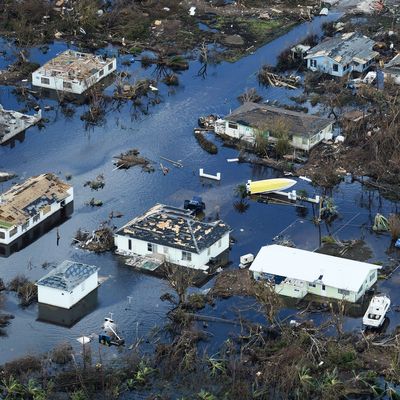
It’s been a week since hurricane Dorian, one of the most powerful Atlantic hurricanes ever recorded, hit the Bahamas, and the damage left in its wake is still being accounted for. Here’s what we know so far.
It’s the most destructive storm to hit Abaco and Grand Bahama Islands.
The Washington Post reported last week that “Dorian will go down in infamy as being the most destructive storm to hit Grand Bahama Island or Great Abaco Island.” The hurricane’s onslaught was particularly acute because it stalled over Abaco and and Grand Bahama, hardly moving as it continued to wreak havoc (the hurricane reportedly pummeled the Bahamas for more than two days).
Research shows that climate change is instigating stronger, more deadly storms. Recent powerful hurricanes have also increasingly been stagnating once they make landfall. The connection between stalled hurricanes and climate change is still under consideration. One hypothesis being studied, according to PBS, is that rising temperatures at the poles are reducing winds that in the past carried hurricanes briskly along.
On Tuesday Denis McClean, a spokesperson for the U.N. Office for Disaster Risk Reduction, said of the connection between more powerful hurricanes and climate change:
“This is the fourth consecutive year that we have witnessed an extremely devastating Atlantic hurricane season, including Category 5 hurricanes like Dorian. The sequence cannot be divorced from the fact that these last five years have been the hottest ever recorded because of the continuing rise in greenhouse gases in the atmosphere. Hurricane Dorian crystallizes the existential threat posed to small island developing states by the ongoing climate emergency. This is an enormous humanitarian and development challenge for the Bahamas.”
The scope of the damage is still unknown.
As of Sunday night, the official death toll is 44.
Up to 90 percent of buildings in the most damaged areas were destroyed. Across the Abaco and Grand Bahama islands a reported 70,000 people have been made homeless and in need of food and water. CNN reports that there is no power or running water on the islands. Access to uncontaminated water is of urgent concern. A resident of Abaco named Matthew Taylor told the Nassau Guardian on Saturday, “It’s unlivable. After the water is gone, what do you do? You know, you have bodies contaminating the water and stuff like that, so the water is undrinkable. That’s where the panic is now.”
According to the Bahamian government, some 3,500 evacuees, most of them displaced from Abaco and Grand Bahama, have made their way to the capital of Nassau. The New York Times reports that the Abacos, which bore the full brunt of the category 5 hurricane and is one of the most devastated areas, is home to many impoverished Haitian immigrants living in shantytowns.
The official number of missing people remains unknown.
Officials told the New York Times on Sunday that no estimate of the number of missing people is currently available, given that Bahamian government workers continue to receive reports of missing and trapped individuals and search the storm debris for bodies. The Times reported from Marsh Harbour that a week after Dorian hit several bodies are clearly visible on the ground and yet “officials could not be reached for comment on why the bodies have not yet been collected.”
Some have asserted that the lack of information indicates a government cover-up of the full damage. Bahamian health minister Duane Sands responded to such speculations on Sunday saying that providing an official body count at this time is simply “not a priority” due to the immense scope of the disaster. Sands told the Miami Herald:
“The priority is find those people for their loved ones who are missing them; to take care, provide comfort to those people who are hurt, who are suffering, that’s the priority. To put food in people’s bellies, water in their throat.”
The geography of the Bahamas, an archipelago consisting of some 700 islands and cays, has further frustrated the disaster relief response. Sands told the Herald, “We are talking about a massive, multi-island operation. We could not land a fixed-wing airplane until two days ago. The harbor was not available because of debris. Most of the vehicles on the ground were destroyed because they were under water. I need people to understand the logistics of this.”
The United States government is reportedly turning away some evacuees.
Thousands of people evacuated by air and sea over the weekend, many of them to the United States, but not all found safe harbor in this country.
On Sunday CNN affiliate WSVN reporter Brian Entin posted footage on Twitter of what appears to be U.S. border control officials informing a ferry full of evacuees leaving Freeport for Fort Lauderdale that anyone without a U.S. visa must disembark. The announcement reportedly resulted in dozens of evacuees being forced off the boat.
U.S. Customs and Border Protection (CBP) responded to these reports in a statement on Sunday:
“CBP was notified of a vessel preparing to embark an unknown number of passengers in Freeport and requested that the operator of the vessel coordinate with U.S. and Bahamian government officials in Nassau before departing The Bahamas…. Everyone who arrives to the United States from another country must present themselves to a CBP officer for inspection at an official CBP Port of Entry. All persons must possess valid identity and travel documents.”
As of Monday morning, CBP Florida was reportedly blaming the incident on the ferry company.




